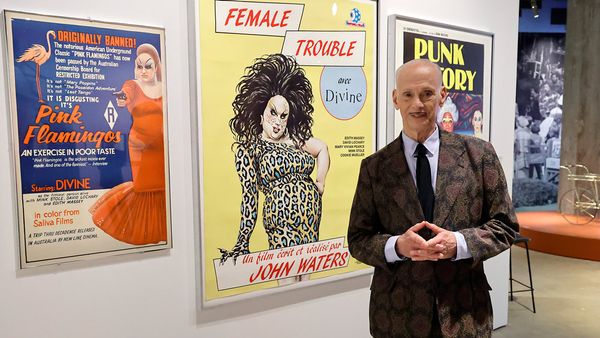
June 11, 2017
Emotionally Charged Creations
Sura Wood READ TIME: 4 MIN.
Hallelujah, and better late than never, are among the responses one may have to "Revelations: Art from the African American South," a truly outstanding, long overdue exhibition at the de Young Museum.
The occasion for the show is FAMSF's recent acquisition of 62 sculptures, paintings, drawings, ingenious, emotionally charged assemblages, quilts from Gee's Bend, and prints based on them, by 22 Southern-born, late-19th and 20th century, African American artists. Though their voices are distinct, collectively their sensibilities have been profoundly shaped by a traumatic shared history: The African Diaspora, in which some 400,000 Africans were kidnapped and sold into bondage in the U.S. beginning in the early 1600s; American slavery, a moral travesty which ripped families apart, scarring its victims and their descendants; enforced segregation and terror in the Jim Crow South; and the civil rights movement. If there's any doubt that racism persists, nooses were recently discovered in a gallery at the National Museum of African American History and Culture, and on the grounds of the Hirshhorn Museum.
Addressing race, class, gender and religion from a vantage point virtually absent from most museum collections, the exhibition is a much-needed corrective that attempts to fill a gaping hole in the annals of contemporary American art, while reminding audiences of what they've been missing. It has been a long time since this many original, wrenching artworks have been gathered in one place. To put it in art-historical terms: the show is pretty great. One caveat: the inclusion of a group of press photographs of the civil rights movement. As important as they are as documents of a critical era, their impact here pales in comparison to interpretive works in other media. Credit for the care and depth on offer is due in large part to the museums' superb curator of American Art, Tim Anglin Burgard, who's a cultural treasure in his own right. All of the works are supplemented by insightful, cogent text labels that enhance understanding and appreciation of artists many don't know and should.
Slaves had their fingers cut off if caught trying to read or write, let alone make art. Still they foraged for materials - a piece of wood here, some string or wire or strips of fabric salvaged there - asserting their existence by creating pictures of freedom, however remote the possibility of their achieving it.
That testament to survival and the transcendent power of art is carried forward by the show's artists, as is the brutal legacy of slavery. One of its most potent symbols, the slave ship, hits you in the solar plexus in Thornton Dial Jr.'s visceral plywood sculpture "The Slave Ship" (1988), which depicts a horrific, bestial scene. The extraordinary piece could initially be mistaken for a hobbyist's model if the vessel weren't a floating hell staged with bloodied mast and bleached planks. On deck, cruel slave-traders, gaunt as wraiths, their mouths agape, lash one captive and throw a net over the head of another as an African woman is raped offshore.
"Lost Cows," a strange, large-scale concoction by the artist's late father, Thornton Dial, is a spectral cattle drive consisting of cow skeletons painted in white enamel. They look like a herd of dinosaur fossils, except for the pelvic bones with holes that refer to the hoods of Ku Klux Klansmen.
A gallery of haunting root-and-branch sculptures includes works steeped in the mystical lore of the ancestors, the conjurers who warded off evil spirits with totems and charms, and the woods themselves, which were sanctuaries for slaves. The gnarled branch lying across a pair of damaged rocking chairs, the smaller "female" one learning against its larger male partner in Lonnie Holley's poignant "His and Her Hold the Root" (1994), harkens back to the elders, family trees and being uprooted and ripped from home ground. Ralph Griffin retrieved driftwood from a stream near his Georgia home for his extraordinary sculpture "Noah's Ark" (1980). The Biblical craft, startling in its fluid beauty, seems to be moving across an unseen body of water, subtly echoing the slave ships that would later ferry his ancestors in chains to the Americas.
Griffin's primitive figures - "Panama Jack" (1984), a grisly apparition with a tilted, partially decapitated head under a straw hat, blood running down its neck, and scarecrow arms lifted slightly away from its body like wings of a wounded bird; and the talismanic "John Getting Graduated" (1983), who's painted with a protective blue coating called "haint" - are bewitching, as are works by Bessie Harvey. Harvey's apocalyptic, beady-eyed, animistic creatures with pink lips and white teeth, like "Beast from Revelation" (1988), resembling a small tree stump with arms, operate in an alternate universe.
Several of the rusted out, square-format sculptures made of riveted crumpled tin by Alabama vernacular artist Ronald Lockett, relate to the cold, hard reality of HIV that took his life in 1998. The harshness of the industrial materials coupled with the raw intensity of the underlying emotion pack a punch in the earthen-colored "Coming Out of the Haze" (1994), which links Lockett's depression, following the shock of his diagnosis, with his surrogate, a wild stag; and "Fever Within" (1995), where the woman he believes infected him hovers, naked and cross-legged, her image limned in nails.
Fellow Alabaman Joe Minter repurposed welded steel for "The Hanging Tree" (1996), an austere, bone-chilling rendering of the last stop for victims of lynching, and a memorial to the 326 African American men women and children and other nameless souls who were slaughtered, sometimes for entertainment, in the artist's home state between 1877 and 1950. Dangling chains, symbolizing slavery, are suspended with metal nooses from rods representing tree limbs that served as makeshift gallows in southern towns. "The whole idea," Minter says, "is to use what has been discarded, just as we as a people have been discarded, made invisible." One hopes that this and other shows like it will help right that wrong.
Through April 1, 2018. famsf.org







